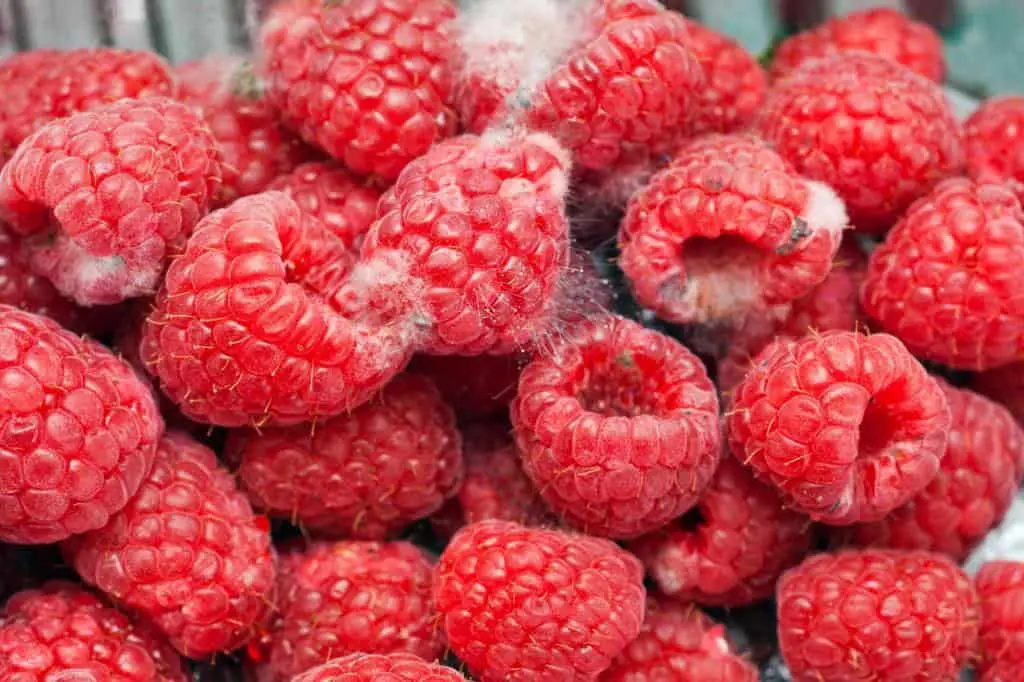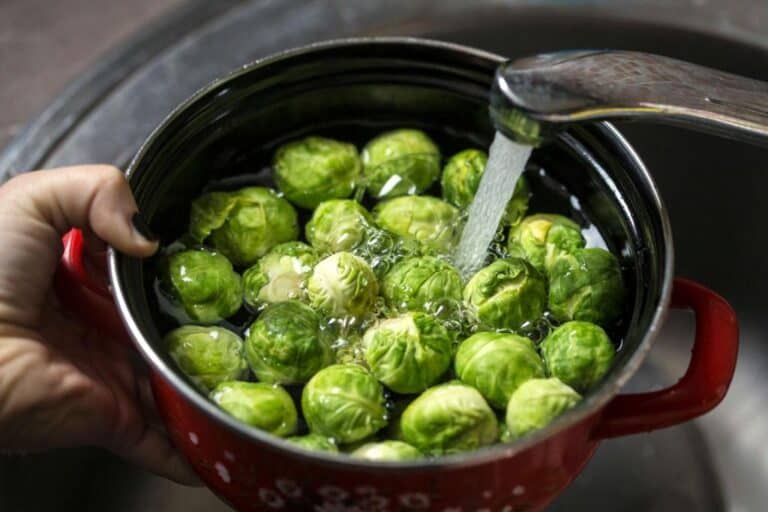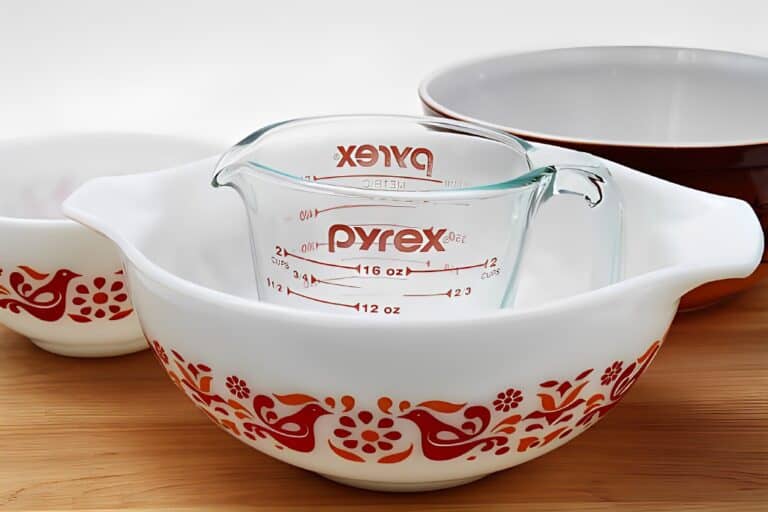Why Do Raspberries Get Mold So Fast? How To Keep It From Molding

Are you a raspberry lover who always ends up throwing away a significant portion of the fruit because it turns into a moldy mess too quickly? Have you ever wondered why raspberries seem to be more prone to molding than other types of fruit?
If so, you’re not alone. Many people love the sweet and tart taste of raspberries, but they can be frustrating to deal with because of their tendency to mold quickly.
Raspberries are delicate fruits with a soft texture and high water content, which makes them more susceptible to spoilage and mold growth. But don’t worry, there are ways to prevent mold growth and keep your raspberries fresh for longer.
In this article, we’ll explore the reasons behind the rapid mold growth on raspberries and provide practical tips on how to keep your berries from molding. With our tips, you’ll be able to enjoy your raspberries without worrying about them going bad before you have a chance to eat them. So, let’s dive in and learn how to keep your raspberries fresh and mold-free!
Importance of Proper Storage for Raspberries
Raspberries require proper storage in order to maintain their freshness and flavor. Improper storage can lead to mold growth and spoilage, causing the berries to become mushy, discolored, and unappetizing. This is why it is crucial to know how to store raspberries correctly, especially if you want to enjoy them for an extended period of time.
One important consideration when storing raspberries is temperature. Raspberries should be kept cool, but not too cold. The ideal temperature for storing raspberries is between 32 and 34°F (0 and 1°C). If the temperature is too warm, raspberries will ripen and spoil quickly, while a temperature that is too cold can damage the fruit and cause it to become mushy.
Another factor to consider when storing raspberries is humidity. Raspberries should be stored in a dry environment to prevent the growth of mold and bacteria. Moisture can cause the berries to become soft and spoil quickly, especially if they are stored for an extended period.
It is also essential to handle raspberries gently when storing them. Raspberries are delicate and can easily bruise or crush if handled roughly. When storing raspberries, avoid stacking them on top of one another or squeezing them tightly into a container. Instead, place them in a single layer in a container and cover them loosely with a lid or plastic wrap.
Along with the right temperature, humidity, and handling, the right container is also important for storing raspberries. The best containers for storing raspberries are shallow and have good ventilation. Avoid using airtight containers or plastic bags, as these can trap moisture and cause the berries to spoil quickly. Instead, you might want to use a plastic container with holes or a colander to let air flow.
Why Do Raspberries Get Mold So Fast?
Raspberries are delicate fruits with a soft texture and a high water content, which makes them prone to spoilage and mold growth. Mold is a type of fungus that thrives in damp environments, and raspberries are an ideal breeding ground for these microorganisms.
When raspberries are picked, they are already vulnerable to mold due to their fragile skin and soft flesh. This, combined with their high sugar content, provides the perfect environment for mold spores to grow and spread quickly.
Exposure to air and physical harm, such as cracks or bruises, accelerate the growth of mold on raspberries. When raspberries are damaged, it creates a pathway for mold spores to enter and infect the fruit, leading to rapid spoilage. Once the mold takes hold, it can quickly spread to other nearby fruits, and before you know it, your entire batch of raspberries is ruined.
How raspberries are picked and handled also has a big impact on how likely they are to grow mold. Raspberries can get bruised or broken if they aren’t washed or handled properly, which gives mold spores a place to grow. It is essential to handle raspberries gently and wash them carefully to avoid damaging the fruit’s delicate skin.
Microbial contamination can also contribute to the rapid mold growth of raspberries. Bacteria and fungi are common microorganisms found on raspberries, and some strains can cause spoilage and mold formation. Use good sanitation procedures when picking, handling, and storing raspberries to prevent contamination by microorganisms.
How Fast Can Mold Grow On Raspberries?
Mold growth on raspberries can occur at an alarmingly rapid rate, even if the berries appear perfectly healthy at harvest. Once mold spores have taken hold on raspberries, it only takes 24 to 48 hours for the fruit to turn into a moldy mass.
Mold spores are everywhere, and they are just waiting for the perfect environment to thrive, and raspberries provide an ideal setting.
The growth rate of mold on raspberries can vary depending on several factors, such as the type of mold, the temperature, and the level of moisture.
Warm and humid conditions are perfect for mold growth, and raspberries thrive in these types of environments, making them highly susceptible to mold formation. When raspberries are stored at temperatures above 40°F, the growth rate of mold spores on the fruit increases dramatically.
The type of mold that grows on raspberries can also impact the speed of growth. Some strains of mold are more aggressive and can spread more quickly than others.
For example, gray mold, or Botrytis cinerea, is a common strain of mold that affects raspberries and is notorious for its rapid growth rate. This type of mold can spread quickly from berry to berry, infecting entire batches of raspberries within a matter of hours. This is why raspberries get mold so fast.
Another factor that can impact the growth rate of mold on raspberries is the level of moisture present. Raspberries have a high water content, and excess moisture can create an ideal environment for mold growth. Water droplets on the surface of raspberries can create a breeding ground for mold spores, leading to rapid spoilage and mold formation.
Pay attention to the remaining of the raspberries, if one raspberry has mold, the rest will eventually are bad. This is because mold spores can easily spread throughout the container and contaminate other berries, making salvaging the remaining raspberries difficult.
How To Keep Raspberries From Molding
There are several ways to keep raspberries from molding, and it all starts with proper storage.
1. Rinse in Vinegar Solution
One of the most effective ways to keep raspberries from molding is to rinse them in a vinegar solution. This helps to kill any bacteria or mold spores on the surface of the berries. To do this, simply mix one part white vinegar with three parts water, then gently rinse the raspberries in the solution. Be sure to rinse them thoroughly with fresh water afterward to remove any vinegar taste.
2. Dry Thoroughly Before Stroring
Another way to prevent mold growth on raspberries is to dry them thoroughly before storing them. Excess moisture can lead to mold growth, so you want to remove as much water as possible. Use a paper towel or a clean kitchen towel to gently pat the raspberries dry, then lay them out on a dry towel to air dry for a few minutes.
3. Store in The Right Container
Choosing the right container is equally important when it comes to keeping raspberries from molding. As we’ve already talked about, raspberries should be kept in a shallow container with good air circulation. This helps to prevent moisture buildup, which can lead to mold growth. A colander or a plastic container with holes in it works well for storing raspberries.
4. Keep in Fridge
Another way to prevent mold growth on raspberries is to store them in the fridge as soon as possible after purchasing them. Raspberries are highly perishable and can spoil quickly at room temperature. To keep them fresh longer, store them in the fridge. Make sure to avoid stacking the raspberries on top of each other, as this can cause them to become crushed and moldy.
5. Check Regularly
Lastly, check your raspberries regularly for signs of spoilage. Mold growth can quickly spread from one berry to another, so if you find one, you need to remove any berries that show signs of mold growth immediately.
Look for soft, mushy, or discolored berries and remove them from the container. Doing this regularly will help to prevent mold growth from spreading and keep your raspberries fresh for longer.
Is It Ok To Eat Raspberries With a Little Mold?
When it comes to eating raspberries, it’s natural to wonder if it’s okay to consume them if you see a little bit of mold. While mold growth on raspberries is a common occurrence, it can also be a concern for some people, especially those with compromised immune systems.
WARNING
According to food safety experts, if you notice any visible mold on your raspberries, it’s best to discard them. Mold can produce toxins that can be harmful to your health, and even a small amount of mold can indicate that the berries are no longer safe to eat. This is especially true for people who have weak immune systems and are more likely to get sick from food.
However, if there are no visible signs of mold on your raspberries, they should be safe to consume. This is because mold tends to grow on the surface of the berries, and if it hasn’t spread to the interior, the raspberry is still considered safe to eat. You should still be cautious, though, and inspect your raspberries closely before eating them.
To lower the chance of eating moldy raspberries, store and handle them the right way. As mentioned earlier, make sure to rinse and dry your berries thoroughly before consuming them. Also, raspberries should always be kept in the fridge, either in their original packaging or in a container with a lid. This will help to slow down the growth of mold and extend the shelf life of your berries.






